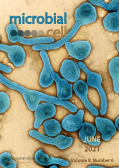Table of contents
Volume 8, Issue 6, pp. 111 - 145, June 2021
Cover: olorized transmission electron micrograph of Marburg virus particles (blue) harvested from infected VERO E6 cell supernatant. Image captured and color-enhanced at the National Institute of Allergy and Infectious Diseases (NIAID), National Institutes of Health, Integrated Research Facility in Fort Detrick, Maryland (USA); the image was retrieved via Flickr and modified by MIC. The cover is published under the Creative Commons Attribution (CC BY) license.
Enlarge issue cover
Mechanisms underlying lactic acid tolerance and its influence on lactic acid production in Saccharomyces cerevisiae
Arne Peetermans, María R. Foulquié-Moreno and Johan M. Thevelein
Reviews |
page 111-130 | 10.15698/mic2021.06.751 | Full text | PDF |
Abstract
One of the major bottlenecks in lactic acid production using microbial fermentation is the detrimental influence lactic acid accumulation poses on the lactic acid producing cells. The accumulation of lactic acid results in many negative effects on the cell such as intracellular acidification, anion accumulation, membrane perturbation, disturbed amino acid trafficking, increased turgor pressure, ATP depletion, ROS accumulation, metabolic dysregulation and metal chelation. In this review, the manner in which Saccharomyces cerevisiae deals with these issues will be discussed extensively not only for lactic acid as a singular stress factor but also in combination with other stresses. In addition, different methods to improve lactic acid tolerance in S. cerevisiae using targeted and non-targeted engineering methods will be discussed.
Proanthocyanidin-enriched cranberry extract induces resilient bacterial community dynamics in a gnotobiotic mouse model
Catherine C. Neto, Benedikt M. Mortzfeld, John R. Turbitt, Shakti K. Bhattarai, Vladimir Yeliseyev, Nicholas DiBenedetto, Lynn Bry and Vanni Bucci
Research Reports |
page 131-142 | 10.15698/mic2021.06.752 | Full text | PDF |
Abstract
Cranberry consumption has numerous health benefits, with experimental reports showing its anti-inflammatory and anti-tumor properties. Importantly, microbiome research has demonstrated that the gastrointestinal bacterial community modulates host immunity, raising the question of whether the cranberry-derived effect may be related to its ability to modulate the microbiome. Only a few studies have investigated the effect of cranberry products on the microbiome to date. Especially because cranberries are rich in dietary fibers, the extent of microbiome modulation by polyphenols, particularly proanthocyanidins (PACs), remains to be shown. Since previous work has only focused on long-term effects of cranberry extracts, in this study we investigated the effect of a water-soluble, PAC-rich cranberry juice extract (CJE) on the short-term dynamics of a human-derived bacterial community in a gnotobiotic mouse model. CJE characterization revealed a high enrichment in PACs (57%), the highest ever utilized in a microbiome study. In a 37-day experiment with a ten-day CJE intervention and 14-day recovery phase, we profiled the microbiota via 16S rRNA sequencing and applied diverse time-series analytics methods to identify individual bacterial responses. We show that daily administration of CJE induces distinct dynamic patterns in bacterial abundances during and after treatment, before recovering resiliently to pre-treatment levels. Specifically, we observed an increase of Akkermansia muciniphila and Clostridium hiranonis at the expense of Bacteroides ovatus after the offset of the selection pressure imposed by the PAC-rich CJE. This demonstrates that termination of an intervention with a cranberry product can induce changes of a magnitude as high as the intervention itself.
DNA polymerase III protein, HolC, helps resolve replication/transcription conflicts
Susan T. Lovett
Microreviews |
page 143-145 | 10.15698/mic2021.06.753 | Full text | PDF |
Abstract
In Escherichia coli, DNA replication is catalyzed by an assembly of proteins, the DNA polymerase III holoenzyme. This complex includes the polymerase and proofreading subunits, the processivity clamp and clamp loader complex. The holC gene encodes an accessory protein (known as χ) to the core clamp loader complex and is the only protein of the holoenzyme that binds to single-strand DNA binding protein, SSB. HolC is not essential for viability although mutants show growth impairment, genetic instability and sensitivity to DNA damaging agents. In this study we isolate spontaneous suppressor mutants in a holC∆ strain and identify these by whole genome sequencing. Some suppressors are alleles of RNA polymerase, suggesting that transcription is problematic for holC mutant strains, and of sspA, stringent starvation protein. Using a conditional holC plasmid, we examine factors affecting transcription elongation and termination for synergistic or suppressive effects on holC mutant phenotypes. Alleles of RpoA (α), RpoB (β) and RpoC (β’) RNA polymerase holoenzyme can partially suppress loss of HolC. In contrast, mutations in transcription factors DksA and NusA enhanced the inviability of holC mutants. HolC mutants showed enhanced sensitivity to bicyclomycin, a specific inhibitor of Rho-dependent termination. Bicyclomycin also reverses suppression of holC by rpoA, rpoC and sspA. An inversion of the highly expressed rrnA operon exacerbates the growth defects of holC mutants. We propose that transcription complexes block replication in holC mutants and Rho-dependent transcriptional termination and DksA function are particularly important to sustain viability and chromosome integrity.










